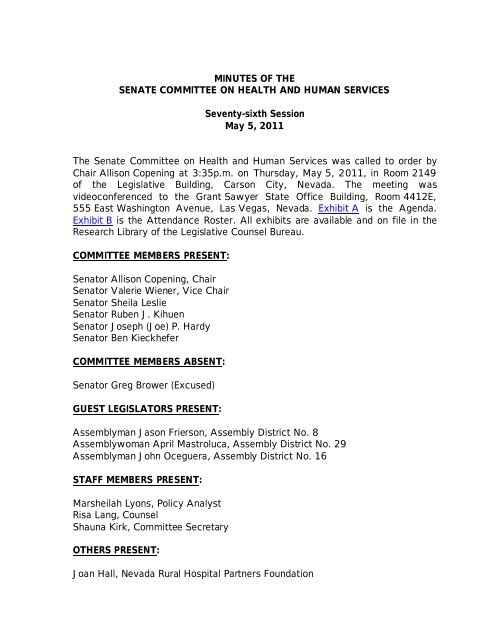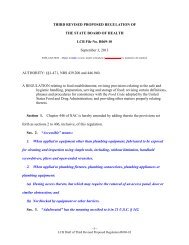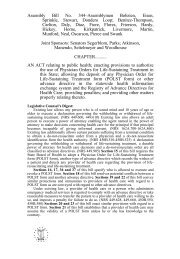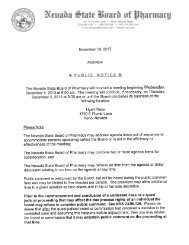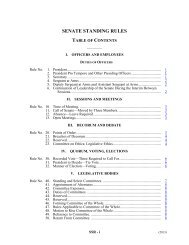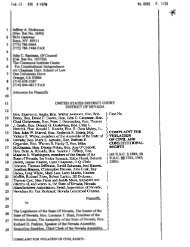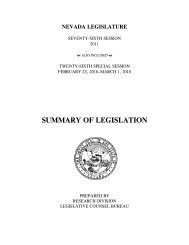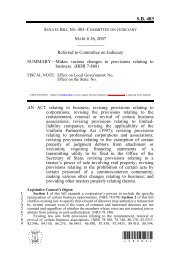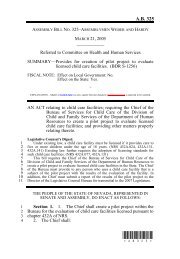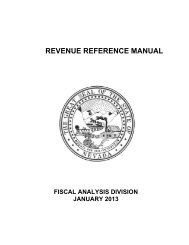SENATE COMMITTEE MINUTES - Nevada Legislature
SENATE COMMITTEE MINUTES - Nevada Legislature
SENATE COMMITTEE MINUTES - Nevada Legislature
You also want an ePaper? Increase the reach of your titles
YUMPU automatically turns print PDFs into web optimized ePapers that Google loves.
<strong>MINUTES</strong> OF THE<br />
<strong>SENATE</strong> <strong>COMMITTEE</strong> ON HEALTH AND HUMAN SERVICES<br />
Seventy-sixth Session<br />
May 5, 2011<br />
The Senate Committee on Health and Human Services was called to order by<br />
Chair Allison Copening at 3:35p.m. on Thursday, May 5, 2011, in Room 2149<br />
of the Legislative Building, Carson City, <strong>Nevada</strong>. The meeting was<br />
videoconferenced to the Grant Sawyer State Office Building, Room 4412E,<br />
555 East Washington Avenue, Las Vegas, <strong>Nevada</strong>. Exhibit A is the Agenda.<br />
Exhibit B is the Attendance Roster. All exhibits are available and on file in the<br />
Research Library of the Legislative Counsel Bureau.<br />
<strong>COMMITTEE</strong> MEMBERS PRESENT:<br />
Senator Allison Copening, Chair<br />
Senator Valerie Wiener, Vice Chair<br />
Senator Sheila Leslie<br />
Senator Ruben J. Kihuen<br />
Senator Joseph (Joe) P. Hardy<br />
Senator Ben Kieckhefer<br />
<strong>COMMITTEE</strong> MEMBERS ABSENT:<br />
Senator Greg Brower (Excused)<br />
GUEST LEGISLATORS PRESENT:<br />
Assemblyman Jason Frierson, Assembly District No. 8<br />
Assemblywoman April Mastroluca, Assembly District No. 29<br />
Assemblyman John Oceguera, Assembly District No. 16<br />
STAFF MEMBERS PRESENT:<br />
Marsheilah Lyons, Policy Analyst<br />
Risa Lang, Counsel<br />
Shauna Kirk, Committee Secretary<br />
OTHERS PRESENT:<br />
Joan Hall, <strong>Nevada</strong> Rural Hospital Partners Foundation
Senate Committee on Health and Human Services<br />
May 5, 2011<br />
Page 2<br />
Erin McMullen, Hospital Corporation of America, Inc.<br />
Steve Winters<br />
Leslie Johnstone, Health Services Coalition<br />
Barry Gold, Director, Government Relations, AARP <strong>Nevada</strong><br />
Nancy Nikolski, RN, Culinary Health Fund<br />
Kevin Schiller, Social Services Director, Department of Social Services, Washoe<br />
County<br />
Diane J. Comeaux, Administrator, Division of Child and Family Services,<br />
Department of Health and Human Services<br />
Alex Ortiz, Clark County<br />
Barbara deCastro, <strong>Nevada</strong> Youth Care Providers<br />
Jennifer L. Silverman, Attorney, Legal Aid Center of Southern <strong>Nevada</strong>;<br />
Children’s Attorneys Project<br />
Karen Zavora, Attorney, Washoe Legal Services<br />
JoAnne Witter, Family Services Supervisor, Department of Family Services,<br />
Clark County<br />
Miriya Lawrence<br />
Felicia Toews<br />
DaShun Jackson<br />
Robert Branson<br />
Angela Foremaster<br />
William E. Fowler, Executive Director, <strong>Nevada</strong> CASA Association<br />
Amber Howell, Deputy Administrator, Family Programs, Division of Child and<br />
Family Services, Department of Health and Human Services<br />
CHAIR COPENING:<br />
We will open the meeting with Assembly Bill (A.B.) 280.<br />
ASSEMBLY BILL 280 (1st Reprint): Requires the adoption of patient safety<br />
checklists and patient safety policies at certain medical facilities.<br />
(BDR 40-517)<br />
ASSEMBLYMAN JOHN OCEGUERA (Assembly District No. 16):<br />
You have been given a copy of my presentation “AB 280 Patient Protection<br />
Checklists, Improving patient health outcomes” (Exhibit C).<br />
Hand washing may not cover gloves, foam or new technologies, and that is<br />
why we were broad in that regard.
Senate Committee on Health and Human Services<br />
May 5, 2011<br />
Page 3<br />
SENATOR KIECKHEFER:<br />
Section 1, subsection 3, of the bill is about appropriately identifying a patient<br />
with two identifiers. Is that something used in an emergency situation?<br />
ASSEMBLYMAN OCEGUERA:<br />
This is to identify the correct patient before a surgical procedure.<br />
JOAN HALL (<strong>Nevada</strong> Rural Hospital Partners Foundation):<br />
It is also for unidentified patients. A patient’s armband will say John Doe, white<br />
male, for identification until further identification can be made.<br />
SENATOR KIECKHEFER:<br />
Are the policies different for emergency care and inpatient care?<br />
MS. HALL:<br />
They are different. If a person has identification, we would use the same<br />
criteria.<br />
The <strong>Nevada</strong> Rural Hospital Partners Foundation supports this bill as it was<br />
passed in the Assembly. We have various audit tools and checklists used in<br />
<strong>Nevada</strong> hospitals which monitor infection-control practices related to hand<br />
hygiene. The acknowledgement in A.B. 280, section 1, subsection 3,<br />
paragraph (b) of the Centers for Disease Control and Prevention’s (CDC)<br />
nationally recognized standard precautionary protocols versus the specific term<br />
“hand washing” is very important. Hand washing is included in these protocols,<br />
but it is not exclusive. As a nurse for over 25 years, I can attest to the<br />
importance of hand washing. Evidence-based studies have shown the science of<br />
infection control is an evolving and improving process.<br />
SENATOR LESLIE:<br />
One of the amendments coming forward includes hand washing as one of the<br />
accepted protocols. How do you feel about that language?<br />
MS. HALL:<br />
Including hand washing is shortsighted and outdated. The CDC’s standard<br />
precautions include hand washing.
Senate Committee on Health and Human Services<br />
May 5, 2011<br />
Page 4<br />
SENATOR LESLIE:<br />
When we had the hepatitis C crisis in Las Vegas, one of the responses from the<br />
industry was that patients need to speak up if they do not see a doctor wash<br />
his or her hands.<br />
MS. HALL:<br />
Studies done by the CDC have shown there is better compliance with hand gel,<br />
because it can be at the bedside.<br />
ERIN MCMULLEN (Hospital Corporation of America, Inc.):<br />
The Hospital Corporation of America, Inc. supports this bill. It is reasonable, well<br />
thought out and clarifies existing procedures.<br />
STEVE WINTERS:<br />
Clostridium difficile (C. diff) can only be removed from someone’s hands by<br />
hand washing. My mother died of C. diff and septic shock that was passed to<br />
her by someone in the health-care facility. Hands touching hands are how<br />
superbugs are spread. If you look at the data, the doctors are the worst<br />
offenders. They are washing their hands less than half of the time when going<br />
between patients. That is a big problem. At least 40 percent of patients die<br />
within 30 days of becoming infected. When performance is measured,<br />
performance improves. I do not see the hospitals regulating their performance.<br />
The Health Division, Department of Health and Human Services (DHHS), has<br />
stated our State has significant deficiencies in areas of infection control and<br />
prevention. There are reports that specifically identify sterilization and<br />
disinfection as the most significant cause of concern for potential health-care<br />
associated infections and outbreaks in ambulatory-surgery centers. Instead of<br />
taking care of the problem, the hospitals are hiding the facts and the numbers,<br />
and people are dying. The John S. Hopkins Hospital reduced their infection rate<br />
by approximately 70 percent to 90 percent simply because staff are washing<br />
their hands. What is not in the bill is hand washing before and after leaving a<br />
patient. Using gels and hand wipes are not effective. Other than that portion of<br />
the bill, I am in support of the bill. If the doctors would have been washing their<br />
hands with soap and water, my mother would be here today. Mandating that<br />
doctors use soap and water should be included in the bill, because it saves<br />
lives.
Senate Committee on Health and Human Services<br />
May 5, 2011<br />
Page 5<br />
LESLIE JOHNSTONE (Health Services Coalition):<br />
The Health Services Coalition (HSC) represents over 270,000 <strong>Nevada</strong>ns who<br />
are covered by self-insured health plans. The HSC supports this bill and the<br />
amendment by Bobbette Bond on behalf of HSC (Exhibit D).<br />
We have a fragmented system and no standardization in the hospital discharge<br />
process. Patients are discharged with minimal and confusing information or are<br />
inundated with information not relevant to their condition. In most cases, the<br />
patients are still ill and need to reestablish their care with their primary-care<br />
physician within 48 hours of discharge. We require a lot from physicians in the<br />
outpatient setting. We believe hospitals must be a part of the process to provide<br />
and empower patients with knowledge about their medical condition so they<br />
understand the importance of continuing care and can also make an informed<br />
decision. Hospitals need to put forth a consistent effort for successfully<br />
transitioning patients’ care back into the community. Checklists for discharges<br />
have been widely accepted in many industries, including health care. This bill<br />
reinforces the importance of using checklists to achieve consistent medical care.<br />
Discharge processes would also benefit from a consistent checklist approach as<br />
done in other areas of medical care. The purpose of the proposed amendment is<br />
to see that patients have as much information as they need to take care of<br />
themselves when they get out of the hospital. The amendment recognizes not<br />
all pertinent information is available at the time of discharge in every case. It<br />
states hospitals would provide that information by mailing it to patients’ home<br />
addresses or sending it electronically. Patients can come in and get their medical<br />
records after discharge, but relying on that step clearly does not work and is<br />
rarely done. We agree that statutes should not be needed, but this work should<br />
already be happening in hospitals, and patients have a right to know what is<br />
going on with their care. Adopting regulations is something that requires time<br />
and resources. We would prefer to get the specific legislative direction into<br />
statute so hospitals are clear about the policy and patients are clear about what<br />
to expect.<br />
We propose to add language to the checklist regarding hospital-acquired<br />
infections, Exhibit D. We support the legislative requirement that nationally<br />
recognized checklists shown to have improved patient safety and reduced<br />
hospital-acquired infections be adopted by all hospitals in <strong>Nevada</strong>.
Senate Committee on Health and Human Services<br />
May 5, 2011<br />
Page 6<br />
SENATOR LESLIE:<br />
I think this amendment is important. Was this proposed amendment presented<br />
to the Assembly?<br />
MS. JOHNSTONE:<br />
I believe Ms. Bond did that.<br />
ASSEMBLYMAN OCEGUERA:<br />
I would not classify this as an unfriendly amendment. We have had discussions.<br />
I am concerned with the practical aspects of the proposed amendment. It has<br />
good ideas and concepts. However, the discharge summary may not be<br />
available when the patient is discharged. Should we keep the patient in the<br />
hospital until the paperwork is available? It is possible to furnish that information<br />
via electronic mail.<br />
Section 3 of the amendment has a similar issue. We have not come to an<br />
agreement on section 1, subsection 2, paragraph (c), item 5 on page 3 of the<br />
proposed amendment, Exhibit D. The patients’ prescribed medication is not<br />
always available. I am in agreement with the proposed amendment, but I am not<br />
sure if these amendments will work.<br />
SENATOR LESLIE:<br />
If someone is being discharged, why would the discharge summary not be<br />
available?<br />
ASSEMBLYMAN OCEGUERA:<br />
No, it is not always available.<br />
MS. HALL:<br />
Discharge summaries, by federal regulation, are not required for 30 days.<br />
Hospital bylaws typically say five days to seven days, because that is how they<br />
bill. That information is technical. It would be helpful to a primary care provider<br />
for follow-up care. Written discharge instructions are mandated, and we provide<br />
them and believe it meets the need.<br />
SENATOR LESLIE:<br />
What about a patient’s written instructions for follow-up care?
Senate Committee on Health and Human Services<br />
May 5, 2011<br />
Page 7<br />
MS. HALL:<br />
The patient needs them, and they get them.<br />
In a standard discharge instruction, a patient would receive information about<br />
diagnosis, medication, follow-up appointments needed, activities and diet.<br />
SENATOR LESLIE:<br />
What about item 4 on page 3, Exhibit D, that states, “Patient receipt of a<br />
summary of medications prescribed upon discharged [sic]?”<br />
MS. HALL:<br />
It is on there. The checklist which follows section 1, subsection 2,<br />
paragraph (c), item 5 on page 3 of the proposed amendment has been stricken.<br />
It was in the original bill passed in the Assembly and meets the intent.<br />
CHAIR COPENING:<br />
Are the specific instructions for follow-up care mentioned in section 1,<br />
subsection 2, paragraph (c) on line 29, page 2, Exhibit D, currently being done?<br />
MS. HALL:<br />
That is in <strong>Nevada</strong> Revised Statutes (NRS) chapter 439 regarding sentinel events.<br />
It is already being done.<br />
SENATOR WIENER:<br />
There is some language about “ … at the time of discharge, or distributed to the<br />
patient at their known address as soon as available … . “<br />
MS. HALL:<br />
Patients have the right to request their information. Discharge planners try to<br />
send the discharge summary to the primary care provider if it is known.<br />
SENATOR WIENER:<br />
If a test result had not come in yet, are the patients notified they can request<br />
the information be sent to them?<br />
MS. HALL:<br />
I do not know.
Senate Committee on Health and Human Services<br />
May 5, 2011<br />
Page 8<br />
SENATOR HARDY:<br />
A discharge summary is a different document than the discharge instruction.<br />
The discharge instruction is immediate. A patient does not leave the hospital<br />
without it. The bill is clean, but the proposed amendment has some problems.<br />
The physician of record in the hospital as well as the attending physician<br />
outside of the hospital will receive the discharge summary.<br />
BARRY GOLD (Director, Government Relations, AARP <strong>Nevada</strong>):<br />
I have prepared testimony I will read (Exhibit E). On behalf of AARP’s<br />
305,000 members, AARP is in support of this bill and request hand washing for<br />
staff specifically be included as being one of the accepted infection prevention<br />
protocols.<br />
SENATOR LESLIE:<br />
Would facility staff include an accountant who does not have any contact with<br />
the patients?<br />
MR. GOLD:<br />
The hospitals prepare the accepted protocols. The accepted protocols will<br />
address who needs to practice hand hygiene.<br />
MS. HALL:<br />
Section 1, subsection 1, paragraphs (a) through (d) of A.B. 280 specify who<br />
would be involved.<br />
SENATOR LESLIE:<br />
In Mr. Gold’s amendment (Exhibit F), it is in a different area. Do you think that<br />
language is needed where his language states on page 1, line 10 of his<br />
proposed amendment “ … all facility staff … ?” Does it refer back to section 1,<br />
subsection 1?<br />
MS. HALL:<br />
That is what we believe. The patient safety committee of a facility establishes<br />
these checklists, and it involves all of those.<br />
SENATOR LESLIE:<br />
Do you think the wording is needed in his amendment?
Senate Committee on Health and Human Services<br />
May 5, 2011<br />
Page 9<br />
MS. HALL:<br />
No.<br />
SENATOR HARDY:<br />
Hand hygiene is so all-encompassing that we need a paradigm shift from hand<br />
washing to include more than hand washing. The concept of hand hygiene is<br />
important, and we need to reeducate ourselves to the reality that hand washing<br />
cannot do everything. For example, the protocol is for the physician to use a<br />
hand rub before touching the patient and sometimes before the physician<br />
changes the patient’s position in the bed and goes to another part of the body.<br />
Patients may think they are protected by the physicians who go to the sink.<br />
Patients are not protected as well as they would be if physicians were using the<br />
new protocols.<br />
NANCY NIKOLSKI, RN (Culinary Health Fund):<br />
In Las Vegas, we see a lot of readmissions due to misuse of medication.<br />
Patients are discharged from the hospital without understanding their<br />
medications. Medication reconciliation is very important. The hospitals should<br />
try to inform us about different medications patients are using during their<br />
hospital stay. This will help prevent readmissions. The patients are still ill at the<br />
time of discharge, and they need to follow up with their primary physicians<br />
within 24 to 48 hours. Generally, patients do not bring any information to the<br />
follow-up appointment, and the doctor will have no information regarding the<br />
diagnosis or the medication given upon discharge. We need to empower our<br />
patients and give them the knowledge of their own medical condition.<br />
MS. HALL:<br />
Health insurance exchanges and electronic health records will assist in that<br />
process. The medication reconciliation is an issue for health-care providers as<br />
well. The discharge instruction should clearly state what the patient is taking.<br />
The cost for providing this service is something we have to consider.<br />
MR. WINTER:<br />
There is an article on a Website called Cleanroom Technology titled “To Sample<br />
or not to Sample.” In this article, the food industry believes the health-care<br />
industry should take notes from the food industry.<br />
CHAIR COPENING:<br />
We will close the meeting on A.B. 280 and open the meeting on A.B. 350.
Senate Committee on Health and Human Services<br />
May 5, 2011<br />
Page 10<br />
ASSEMBLY BILL 350 (2nd Reprint): Revises provisions governing children who<br />
are placed with someone other than a parent and who are under the<br />
jurisdiction of the juvenile court. (BDR 38-712)<br />
ASSEMBLYWOMAN APRIL MASTROLUCA (Assembly District No. 29):<br />
This bill does two things. The first part of the bill allows children who are<br />
18 years of age and still in school to stay in the foster-care system until they<br />
have graduated from high school. We want to encourage our foster children to<br />
graduate and make sure they are on the right path to move forward. Section 16<br />
on page 12 of A.B. 350 requires that a child 17 years of age who is not likely to<br />
be returned to the custody of his or her parents be provided an attorney to put<br />
together a plan about jurisdiction. The plan requires the child to save enough<br />
money to pay for monthly expenses for at least three months and to stay in<br />
high school or get the equivalent diploma. The plan must establish that if they<br />
have graduated from high school, they can enroll in a postsecondary vocational<br />
program, actively seek employment, secure housing and make sure they have<br />
income to meet expenses. These are the things we would ask of our own<br />
children if they were moving out. In foster care, children do to not always have<br />
these opportunities. It is the responsibility of the child to complete the plan.<br />
The second subject of the bill begins on page 17. It deals with fictive kin.<br />
Fictive kin is someone with whom the child has a relationship who is not a<br />
relative. When a child is removed from a home, there is an order of preference<br />
about how it is determined where that child is placed. If the child needs<br />
hospitalization, the hospital would be the first priority. This bill adds fictive kin<br />
at the same level as relatives. This allows children to stay with someone with<br />
whom they are familiar and comfortable and with whom have a relationship.<br />
SENATOR WIENER:<br />
In section 18, subsection 2, paragraph (d), it says “The child reaches of [sic] the<br />
age of 21 years, … .” Is there a possibility of a plan where that particular<br />
18-year-old still needs some additional nurturing until reaching 20 years of age?<br />
ASSEMBLYWOMAN MASTROLUCA:<br />
We have not had that discussion. The challenges we have with many of these<br />
children are that they want to leave the system. We are allowed to pay and<br />
would receive reimbursement for them up to 21 years of age.
Senate Committee on Health and Human Services<br />
May 5, 2011<br />
Page 11<br />
SENATOR KIECKHEFER:<br />
In section 18, subsection 4, paragraph (a) the child can voluntarily request the<br />
court to retain jurisdiction over the child when aging out of the child welfare<br />
system. What is the logic for doing that? What types of jurisdiction does the<br />
court have over an adult who is there at their own will?<br />
ASSEMBLYWOMAN MASTROLUCA:<br />
If they choose to stay, they will still have access to health care. There are<br />
different programs that allow for some financial help.<br />
SENATOR WIENER:<br />
Does that address section 18, subsection 7?<br />
ASSEMBLYWOMAN MASTROLUCA:<br />
Correct.<br />
KEVIN SCHILLER (Social Services Director, Department of Social Services,<br />
Washoe County):<br />
The Department of Social Services (DSS), Washoe County, enters into<br />
agreements with youth who are aging out of care to provide independent-living<br />
services. This population is the most difficult population we serve. This bill<br />
increases the accountability of DSS in terms of services being provided, and<br />
creates some oversight to the youth who often have difficulty. It also outlines in<br />
statutes specific areas the DDS must address. If we have a youth who is<br />
struggling in an independent-living apartment, we can go back to the court.<br />
SENATOR HARDY:<br />
How long is this service available to the child, and what services are still<br />
available?<br />
MR. SCHILLER:<br />
Twenty-one years of age is the cutoff age. The youth must be enrolled in school<br />
and there are requirements in other areas for the youth to be on the<br />
independent-living agreement. Medicaid and other benefits would apply under<br />
the 18 years to 21 years of age window. The youth with whom we have<br />
success in this range usually age out at approximately 19 years of age. If we<br />
are doing our job correctly, we are showing them how to get sustainable<br />
finances, medical insurance and vocational training. The cutoff age legally is<br />
21 years of age.
Senate Committee on Health and Human Services<br />
May 5, 2011<br />
Page 12<br />
SENATOR HARDY:<br />
There is a fiscal note of $10 million with the State agencies.<br />
ASSEMBLYWOMAN MASTROLUCA:<br />
I believe it has been updated.<br />
DIANE J. COMEAUX (Administrator, Division of Child and Family Services,<br />
Department of Health and Human Services):<br />
When this bill originally came out, we were looking at a potential population of<br />
190 children statewide. For rural areas, we have a population of about<br />
12 children who would have qualified. One opted to take it. There will be no<br />
fiscal impact with the amendments.<br />
SENATOR HARDY:<br />
I understand Mr. Schiller to be saying there are Medicaid funds involved. Do we<br />
not have to match them on a State basis?<br />
MS. COMEAUX:<br />
A number of years ago, we extended Medicaid to children until 21 years of age.<br />
It is already in the budget.<br />
CHAIR COPENING:<br />
During the aging-out period of 18 years to 21 years of age, the children are<br />
given a stipend. If they opt to stay within a foster-care system, do the foster<br />
parents also get their regular stipend?<br />
MR. SCHILLER:<br />
If the child opts to stay in the foster-care setting, they pay rent to that<br />
foster-care provider. We have the fiscal responsibility to manage the money. We<br />
only change the vehicle by which the foster-care payment occurs through the<br />
voluntary agreement.<br />
CHAIR COPENING:<br />
Section 19 sets a goal for the child to save enough money to pay for<br />
three months of expenses. Where do they get the money to do that?<br />
MR. SCHILLER:<br />
The rental cost-of-care payment is separate. We set up an independent-living<br />
plan and focus on what they can do vocationally, where they can gain income
Senate Committee on Health and Human Services<br />
May 5, 2011<br />
Page 14<br />
oversee these placements. In Clark County, the court does oversee the<br />
placements.<br />
ASSEMBLYWOMAN MASTROLUCA:<br />
The population being dealt with compared to the child welfare system overall is<br />
very small.<br />
MR. SCHILLER:<br />
Washoe County has approximately 30 children in this population who have aged<br />
out of NRS 432B cases.<br />
SENATOR WIENER:<br />
What is the success rate?<br />
MR. SCHILLER<br />
It is not good. Approximately 30 percent to 40 percent of the children<br />
successfully get a diploma and move into independent living. The intent is to<br />
provide additional oversight to this population. We start working with the<br />
children at approximately 15 years of age.<br />
SENATOR HARDY:<br />
Where is Clark County in all of this?<br />
ALEX ORTIZ (Clark County):<br />
Clark County supports this amended version of the bill.<br />
SENATOR KIECKHEFER:<br />
I would like to make sure we are consistent regarding fictive kin. How will the<br />
appropriate place for a child be identified?<br />
MR. SCHILLER:<br />
The fictive kin component is still placed in the order of preference. When a child<br />
is removed, there is an immediate requirement to reach out to relatives or<br />
anyone who has an association with the child. Relatives have preference in<br />
foster placement and adoption. It is common to have teachers and other<br />
professionals come forward with input. The different relationships are evaluated<br />
and worked through before any final decisions are made.
Senate Committee on Health and Human Services<br />
May 5, 2011<br />
Page 15<br />
ASSEMBLYWOMAN MASTROLUCA:<br />
The definition of fictive kin is in section 22, subsection 10 of the bill.<br />
BARBARA DECASTRO (<strong>Nevada</strong> Youth Care Providers):<br />
The <strong>Nevada</strong> Youth Care Providers fully support this bill.<br />
JENNIFER L. SILVERMAN (Attorney, Legal Aid Center of Southern <strong>Nevada</strong>;<br />
Children’s Attorneys Project):<br />
I am here in support of A.B. 350. The Children’s Attorneys Project represents<br />
abused and neglected children in the foster-care system in southern <strong>Nevada</strong>.<br />
There are 10 full-time staff attorneys and approximately 250 pro bono<br />
attorneys. This bill is crucial to many of the children who are aging out of the<br />
foster-care system. <strong>Nevada</strong> Revised Statute chapter 432 states the definition of<br />
a child as someone under 18 years of age or who is still in high school. In<br />
Clark County, it was the unspoken policy that children not be terminated from<br />
court jurisdiction until they graduated from high school. Last year, concerns<br />
were raised that the statute was unclear; every child 18 years of age had<br />
concerns about their cases being closed. Everyone agreed to allow the<br />
<strong>Legislature</strong> to clarify the issue. This bill amends the law to define a child as<br />
someone less than 18 years of age, or who is under the jurisdiction of the court.<br />
As we stated, the child welfare agency will no longer retain legal custody.<br />
However, the court will still have the power to terminate the court jurisdiction<br />
if, for instance, a child is not making good-faith efforts to maintain a plan.<br />
KAREN ZAVORA (Attorney, Washoe Legal Services):<br />
I am a child advocacy attorney for Washoe Legal Services. We represent almost<br />
half of the children in foster care in Washoe County. Over half of the youth who<br />
age out of foster care experience one or more episodes of homelessness. Nearly<br />
30 percent will be incarcerated at some point. They are less likely to be<br />
employed than their non-foster-care peers. Less than 2 percent will complete<br />
college compared to 23 percent of their non-foster-care peers. This bill will help<br />
the youth who are asking for help. Without the help of social services, these<br />
children are often left with the choice of returning to their abusers.<br />
I would like to comment about why it is a good idea for the courts to be<br />
involved. Having a judge involved keeps everyone working hard for the best<br />
interest of the child. On behalf of Washoe Legal Services and our child<br />
advocacy program, we strongly support this bill.
Senate Committee on Health and Human Services<br />
May 5, 2011<br />
Page 16<br />
SENATOR HARDY MOVED TO DO PASS A.B. 350.<br />
SENATOR WIENER SECONDED THE MOTION.<br />
THE MOTION CARRIED UNANIMOUSLY.<br />
*****<br />
CHAIR COPENING:<br />
We will now open the hearing on A.B. 154.<br />
ASSEMBLY BILL 154 (2nd Reprint): Enacts provisions which guarantee certain<br />
rights to children placed in foster homes in this State. (BDR 38-802)<br />
ASSEMBLYMAN JASON FRIERSON (Assembly District No. 8):<br />
Assembly Bill 154 creates a bill of rights for foster children. This concept was a<br />
recommendation of the Legislative Committee on Children, Youth and Families<br />
in 2005. The goal of the bill is to codify existing practices with respect to foster<br />
children. When this bill, A.B. No. 36 of the 73rd Session, was originally<br />
presented, there were concerns by various entities involved with the foster-care<br />
system, and the part of the bill related to the provision of public service for<br />
children was not included in the bill that passed. Those various entities have<br />
come together, and A.B. 154 reflects the work of those entities. The intention<br />
is not to create additional obligations for the parties involved. It is to codify, in<br />
one place, the rights of foster-care children and to let them know their rights<br />
and empower them. There is a proposed amendment from Clark County<br />
(Exhibit G). It deals with an identification kit. We consider it to be a friendly<br />
amendment.<br />
Section 3 of A.B. 154 deals with treating children placed in a foster home fairly.<br />
Section 4 is about the placement of children in a foster home, and the rights<br />
they have with respect to their placement.<br />
Section 5 discusses vocational training and education for children in foster<br />
homes and the children’s rights in that area.<br />
Section 7 is the more important provision. It proposes that the provider of foster<br />
care may impose reasonable restrictions on the time, place and manner in which
Senate Committee on Health and Human Services<br />
May 5, 2011<br />
Page 17<br />
a child may exercise his or her rights. It gives notice to everyone of the child’s<br />
rights and helps explain to the foster child his or her rights.<br />
Section 8 empowers children with the ability to raise concerns with various<br />
people involved in the foster-care system.<br />
Section 9 makes sure teachers and education professionals do not identify those<br />
foster-care children to others as foster-care children in the system.<br />
SENATOR HARDY:<br />
What about coaches? Coaches are not employed by the school district. Those<br />
are volunteer positions.<br />
ASSEMBLYMAN FRIERSON:<br />
There will be individuals involved in the lives of these children that we cannot<br />
regulate in statute. We can only go so far, and there will be volunteers at every<br />
level. We can only hope the spirit of this bill is followed.<br />
SENATOR HARDY:<br />
Section 9 needs to be cleaned up. If paramedics come to the school to help a<br />
foster child and they are told the child is in foster care, the person telling the<br />
paramedic is in violation of the law.<br />
ASSEMBLYMAN FRIERSON:<br />
There is only so much we can do.<br />
SENATOR HARDY:<br />
I am concerned with section 8, lines 3 through 5 and the language “ … without<br />
limitation.“<br />
ASSEMBLYMAN FRIERSON:<br />
The issues on how they raise grievances with individuals reflect the current<br />
practice.<br />
SENATOR HARDY:<br />
What is different from what we do now?
Senate Committee on Health and Human Services<br />
May 5, 2011<br />
Page 18<br />
ASSEMBLYMAN FRIERSON:<br />
Nothing is different. The convenience of this bill is that it is all in one place.<br />
Some of these rights exist in NRS and some exist in the <strong>Nevada</strong> Administrative<br />
Code. These foster children have no way to know where to get this information.<br />
SENATOR HARDY:<br />
Do you have a list of those rights and where they were before? There is a<br />
difference between those two things and practice.<br />
ASSEMBLYMAN FRIERSON:<br />
I can provide that.<br />
CHAIR COPENING:<br />
I like the idea it is all in one place. Many times the foster parents and the foster<br />
children do not know their rights. If I understand the intent correctly, it is to<br />
empower them and let them know they have rights.<br />
MS. SILVERMAN:<br />
Many of the children I represent have been physically and sexually abused,<br />
neglected, exposed to drugs and alcohol and in some instances abandoned by<br />
their parents. They are scared, helpless and uncertain when entering the<br />
foster-care system. They do not know they are entitled to be treated with<br />
dignity and respect. Upon entering into a foster-care home, children would be<br />
given a copy of their rights and would know they are entitled to placement with<br />
family, if possible, and reasonable visitation with their family. They would also<br />
know they have the right to food, shelter and treatment free of abuse, neglect<br />
and discrimination. I urge this Committee to enact this bill for all the foster<br />
children in <strong>Nevada</strong> and give them notice of their rights.<br />
SENATOR WIENER:<br />
Is there a mandate for foster parents to read it to the children who cannot read?<br />
How can you confirm a child has been exposed to these rights?<br />
MS. SILVERMAN:<br />
When I come into a home and the child is verbal and can understand, I explain<br />
the concepts to the child to the best of my ability. In addition to a child’s<br />
attorney, there are court-appointed special advocates and a legal guardian who<br />
can explain these rights to them.
Senate Committee on Health and Human Services<br />
May 5, 2011<br />
Page 19<br />
JOANNE WITTER (Family Services Supervisor, Department of Family Services,<br />
Clark County):<br />
I am the supervisor of the Independent Living Skills Program (ILSP) which serves<br />
approximately 425 youths. Approximately 125 youths will age out of the<br />
system at 18 years of age or older. The ILSP was created to assist these youths<br />
in the transition into adulthood by linking them to resources and services to help<br />
them learn daily living skills, money management, educational resources and<br />
finding a lifelong adult connection. The ILSP consists of staff who will work<br />
with the youth to identify youth-driven goals and to work with the youth’s team<br />
to help achieve these goals by the time they exit care. One of the main goals of<br />
the ILSP is to empower youths to advocate for themselves. This bill enables<br />
youths to have control in their lives when an adult has taken it away from them.<br />
It will empower the youths of <strong>Nevada</strong> to take charge of their future and give<br />
them a voice to remind others of how important they are. It was important the<br />
bill be written in a language for youth and by youth to make sense for those<br />
who are reading it or when someone is trying to explain it to them. During a<br />
meeting of the <strong>Nevada</strong> Life Youth Advisory Board (YAB), young adults received<br />
input from all jurisdictions and made the recommended changes. Through the<br />
coordination of many organizations, recommendations and suggestions that<br />
were received, the content of A.B. 154 was created.<br />
SENATOR HARDY:<br />
I have heard the youth wrote this, and I have heard it was brought in from<br />
different places.<br />
ASSEMBLYMAN FRIERSON:<br />
The children wrote the bill. The rights they wrote were rights they brought<br />
together from various locations. These are expressions of those rights as they<br />
exist in other areas or in practice.<br />
MIRIYA LAWRENCE:<br />
I was a foster youth for five years. When my siblings and I came into care,<br />
I was 12 years of age. I had been out of school for approximately four months.<br />
I was taken because of sexual abuse and neglect from my mother. We came<br />
into care and stayed at Child Haven, Las Vegas, for approximately three months<br />
before being placed with a wonderful foster family. There was a point when we<br />
were almost adopted by a family in Virginia. However, I was comfortable with<br />
my foster family and wanted to stay with them. I did not know my rights as a<br />
foster youth. I felt obligated and went to Virginia against my better judgment.
Senate Committee on Health and Human Services<br />
May 5, 2011<br />
Page 20<br />
Three months later, the placement did not work out, and we were forced to<br />
come back to <strong>Nevada</strong>. It was a painful time for all of us. We were fortunate<br />
enough to be able to come back to the same foster family. When we returned,<br />
we were referred to an attorney from the Children’s Attorneys Project, Legal Aid<br />
Center of Southern <strong>Nevada</strong>. We learned where we stood as youth. I was able to<br />
decide where my future was going. Now that I am aware of my rights, I can see<br />
where things have fallen short. Because there is no codified or compiled list,<br />
people are unaware of what they are to be doing. Because the foster youths do<br />
not know their rights, they are not able to call out for help. I have a younger<br />
brother and sister. When my brother ages out of foster care, he will have been<br />
in foster care for eight years. When my sister ages out, she will have been in<br />
foster care for ten years. I want to make sure their time in care has met their<br />
needs and that they know to what they are entitled. I want to make sure<br />
children in foster care, and future children in foster care, know they have a<br />
voice.<br />
FELICIA TOEWS:<br />
I have been in the foster-care system since I was 12 years of age. I am now<br />
20 years of age. I was not neglected. We had food, water and heat. However,<br />
my file stated I was taken for lack of heating. My mom tried to get us back<br />
repeatedly. My sister and I were separated. I did not know I had any rights and<br />
was only told what to do. My sister ran away several times, and eventually, she<br />
turned 18 years of age and aged out of foster care. I was lucky enough to be<br />
put in a home for five years with great foster parents. When I aged out, I was<br />
offered a chance to stay with my foster parents and finish high school.<br />
CHAIR COPENING:<br />
When you were separated from your mother, did they make attempts to let you<br />
see her?<br />
MS. TOEWS:<br />
I went almost an entire year without any contact. My mother sent letters I never<br />
received. Eventually, I was able to get visitation rights.<br />
DASHUN JACKSON:<br />
I have written testimony I will read (Exhibit H).
Senate Committee on Health and Human Services<br />
May 5, 2011<br />
Page 21<br />
ROBERT BRANSON:<br />
I was a foster child and am a former YAB treasurer. I am the current treasurer<br />
for YAB in Washoe County.<br />
MR. SCHILLER:<br />
Washoe County Social Services supports this bill. We recognize how important<br />
the youth are in developing our policy and procedures to improve our practice in<br />
their best interest. I cannot emphasize enough how significant and important it<br />
is to improve what we do.<br />
MS. ZAVORA:<br />
I am here on behalf of Jon Sasser. As a child advocacy attorney, I want to<br />
compliment the youth who have stepped up to advocate for themselves today.<br />
MR. BRANSON:<br />
I was put in foster care when I was 15 years of age. My mom and I never got<br />
along, and my dad had medical issues and could not take care of me. I was<br />
selling drugs and had my first gun at 14 years of age. I want to help foster<br />
children in any way possible, and I am in support of this bill.<br />
ANGELA FOREMASTER:<br />
My parents have been foster parents for the past nine years. I am not a foster<br />
youth and have never been in the foster-care program. We have had foster<br />
youth in our home. We had a foster youth in our home waiting to transition with<br />
her sister. At that time, there were problems with school and other choices she<br />
wanted to make. Our family had nowhere to turn to tell her where to go. Her<br />
caseworker was unsure about her rights as well. This bill lets everyone know<br />
those rights and where they can turn.<br />
WILLIAM E. FOWLER (Executive Director, <strong>Nevada</strong> CASA Association):<br />
I have written testimony I will read (Exhibit I).<br />
CHAIR COPENING:<br />
We will close the hearing on A.B. 154 and open the meeting on A.B. 110.<br />
ASSEMBLY BILL 110 (1st Reprint): Establishes the Kinship Guardianship<br />
Assistance Program. (BDR 38-196)
Senate Committee on Health and Human Services<br />
May 5, 2011<br />
Page 22<br />
AMBER HOWELL (Deputy Administrator, Family Programs, Division of Child and<br />
Family Services, Department of Health and Human Services):<br />
This bill seeks to establish the Kinship Guardianship Assistance Program (KGAP)<br />
in <strong>Nevada</strong>. Title II of Public Law No: 110-351, the Fostering Connections to<br />
Success and Increasing Adoptions Act of 2008 (FCSIAA), became public law on<br />
October 7, 2008. The new federal law represents the most significant federal<br />
reforms to foster care in more than a decade. The FCSIAA allows<br />
reimbursement under Title IV—part E—of the Social Security Act, Public Law<br />
106-169 (Title IV-E), when states opt to use Title IV-E funds for<br />
kinship-guardianship payments for children who are cared for by a relative<br />
guardian and are committed to caring for these children permanently by<br />
assuming legal guardianship. When a child must be separated from his or her<br />
parent’s care, it is imperative the family connection is preserved for that child.<br />
Keeping children with family members sustains their connection to their family<br />
roots. They are usually in close proximity to other relatives, including siblings,<br />
which allows them to receive family support that is unavailable or infrequent in<br />
nonrelative placements. Additionally, relative-foster placements may be<br />
beneficial as they minimize trauma by providing the child with a sense of family<br />
support. In <strong>Nevada</strong>, when a child must be removed from his or her home, the<br />
first placement option considered is relative care. Placing youth and children<br />
with relatives can be a powerful means of achieving permanency if they cannot<br />
return home to their parents. There are many reasons a relative or another<br />
caring adult would want to assume legal guardianship instead of adoption.<br />
Subsidized guardianship is often appropriate when a family member would like<br />
to take legal custody of a child but does not feel comfortable terminating the<br />
parental rights of a child’s parent. Every means available should be used to<br />
connect youth with caring adults and should be supported by law, policy and<br />
practice, given the alarming increase in young people who age out of care each<br />
year without a permanent connection. The implementation of the KGAP can<br />
provide permanency for children and youth. Research across the Country shows<br />
that guardianship boosts overall permanency rates for children. Providing other<br />
options such as guardianship for children can reduce the length of time they<br />
remain in foster care. In moving to a guardianship placement, the relative can<br />
still be compensated for caring for the child. This may be a favored alternative<br />
for children who have no plan of reunification or adoption and have a strong<br />
bond with a relative. It would allow those children to achieve permanent<br />
placements and prevent them from lingering in foster care. We ask for this<br />
Committee’s support of this bill.
Senate Committee on Health and Human Services<br />
May 5, 2011<br />
Page 23<br />
CHAIR COPENING:<br />
Will you go through the bill for us?<br />
MS. HOWELL:<br />
Section 2 of A.B. 110, establishes that the DHHS will administer the program.<br />
Section 5 relates to assistance if a relative is located within the State or outside<br />
of the State. Section 6 is about requirements for the children. Some of those<br />
requirements are that they have to be removed from their homes based on a<br />
court order; they have to have lived in the relative’s home for a minimum of<br />
six months; they cannot have a permanent placement option for adoption or<br />
reunification; and, if 14 years of age or older, the child has to be consulted<br />
about the guardianship arrangement. It also lists the requirements of eligibility<br />
for the relative such as demonstrating a strong commitment to caring for the<br />
child, entering into a written agreement, being appointed the legal guardian and<br />
being eligible for Title IV-E payments. Section 7 relates to the agreement<br />
between the agency and the relative, as well as any stipulations to that<br />
agreement. Section 8 discusses the background checks needed. Section 9<br />
relates to steps an agency has to take to determine if an adoption or returning<br />
the child to his or her home is not appropriate. This speaks to the case plan on<br />
which the child and the agency are working.<br />
CHAIR COPENING:<br />
How is this different from what we have in law?<br />
MS. HOWELL:<br />
When a child is placed in our custody, we try to locate a relative first. If that<br />
relative is identified and seems to be the most appropriate placement option, we<br />
place the child with that relative. A relative who receives financial assistance<br />
must become licensed. Although a child may stay with a relative, the relative<br />
may not have an interest in adopting the child. Therefore, the child remains in<br />
foster care because the relative needs the financial assistance, and the child<br />
never receives permanency. This allows the guardianship to be a permanency<br />
option.<br />
CHAIR COPENING:<br />
Does that become an adoption of the child by the relative?
Senate Committee on Health and Human Services<br />
May 5, 2011<br />
Page 24<br />
MS. HOWELL:<br />
They are not adopting the child. They are the legal guardian of the child and<br />
that is what obtains the permanency.<br />
SENATOR KIECKHEFER:<br />
Will you explain section 6, subsection 2 for me?<br />
MS. HOWELL:<br />
If there is a sibling group with only one sibling qualifying for Title IV-E<br />
payments, it allows all of the siblings to qualify and remain in placement<br />
together.<br />
SENATOR KIECKHEFER:<br />
Would that increase your cost?<br />
MS. HOWELL:<br />
If one of the siblings does not qualify, it is funded 100 percent by the General<br />
Fund. It puts that sibling in a category that can be federally funded.<br />
SENATOR KIECKHEFER:<br />
The Title IV-E is not like Medicaid where we can get a match for funds. Is that<br />
correct? I am trying to figure out why the fiscal note shows no income or<br />
expenditure.<br />
MS. COMEAUX:<br />
Title IV-E is exactly like Medicaid. It is an entitlement program. Once children<br />
are determined to be entitled, we are entitled to reimbursement for their<br />
expenses, and it is not capped. There is no fiscal note because these children<br />
are already in placement. They need to be in a licensed foster home. We are<br />
already making payments to the foster home for a minimum of six months<br />
before they even qualify for it. We are already making payments to these<br />
homes.<br />
SENATOR KIECKHEFER:<br />
How would they not be Title IV-E eligible if they are already in foster care?<br />
MS. COMEAUX:<br />
Approximately 54 percent of our overall population are Title IV-E eligible, and<br />
we make foster-care payments for all of the children who are in a licensed
Senate Committee on Health and Human Services<br />
May 5, 2011<br />
Page 25<br />
foster-care home. We are already making payments for a number of children out<br />
of 100 percent State dollars.<br />
SENATOR HARDY:<br />
I am having a hard time understanding who is eligible in section 6, subsection 2.<br />
RISA LANG (Counsel):<br />
If the sibling is not eligible, that sibling can still be placed with the child who is<br />
eligible.<br />
MR. SCHILLER:<br />
If we cannot reunify and move towards permanency for children, we move<br />
towards a subsidized adoption program. In that program, we have payments<br />
that are Title IV-E eligible based on the eligibility of the child which carries<br />
through until the child is 18 years of age. The KGAP almost mirrors that<br />
program. Instead of calling it post-adoption services, it is really<br />
post-guardianship services. We are already providing care for these children, and<br />
it is going to be a transition of those foster-care costs. Last year, approximately<br />
46 percent of our adoptions were relatives. Of that percentage, several moved<br />
into a process where the financial assistance was critical for the permanency.<br />
SENATOR HARDY:<br />
Is the Medicaid option extended as well as the payments?<br />
MR. SCHILLER:<br />
Yes.
Senate Committee on Health and Human Services<br />
May 5, 2011<br />
Page 26<br />
CHAIR COPENING:<br />
We will close the hearing on A.B. 110 and adjourn the Senate Committee on<br />
Health and Human Services meeting at 6:29 p.m.<br />
RESPECTFULLY SUBMITTED:<br />
Shauna Kirk,<br />
Committee Secretary<br />
APPROVED BY:<br />
Senator Allison Copening, Chair<br />
DATE:
Senate Committee on Health and Human Services<br />
May 5, 2011<br />
Page 27<br />
EXHIBITS<br />
Bill Exhibit Witness / Agency Description<br />
A Agenda Agenda<br />
B Attendance Roster Attendance Roster<br />
A.B. 280 C Assemblyman John Oceguera Checklist, Improving<br />
patient health outcomes<br />
A.B. 280 D Leslie Johnstone Bobbette Bond’s<br />
Proposed Amendment<br />
A.B. 280 E Barry Gold Written Testimony<br />
A.B. 280 F Senator Sheila Leslie Barry Gold’s Proposed<br />
Amendment<br />
A.B. 154 G Assemblyman Jason Frierson Clark County Proposed<br />
Amendment<br />
A.B. 154 H DaShun Jackson Written Testimony<br />
A.B. 154 I William E. Fowler Written Testimony


